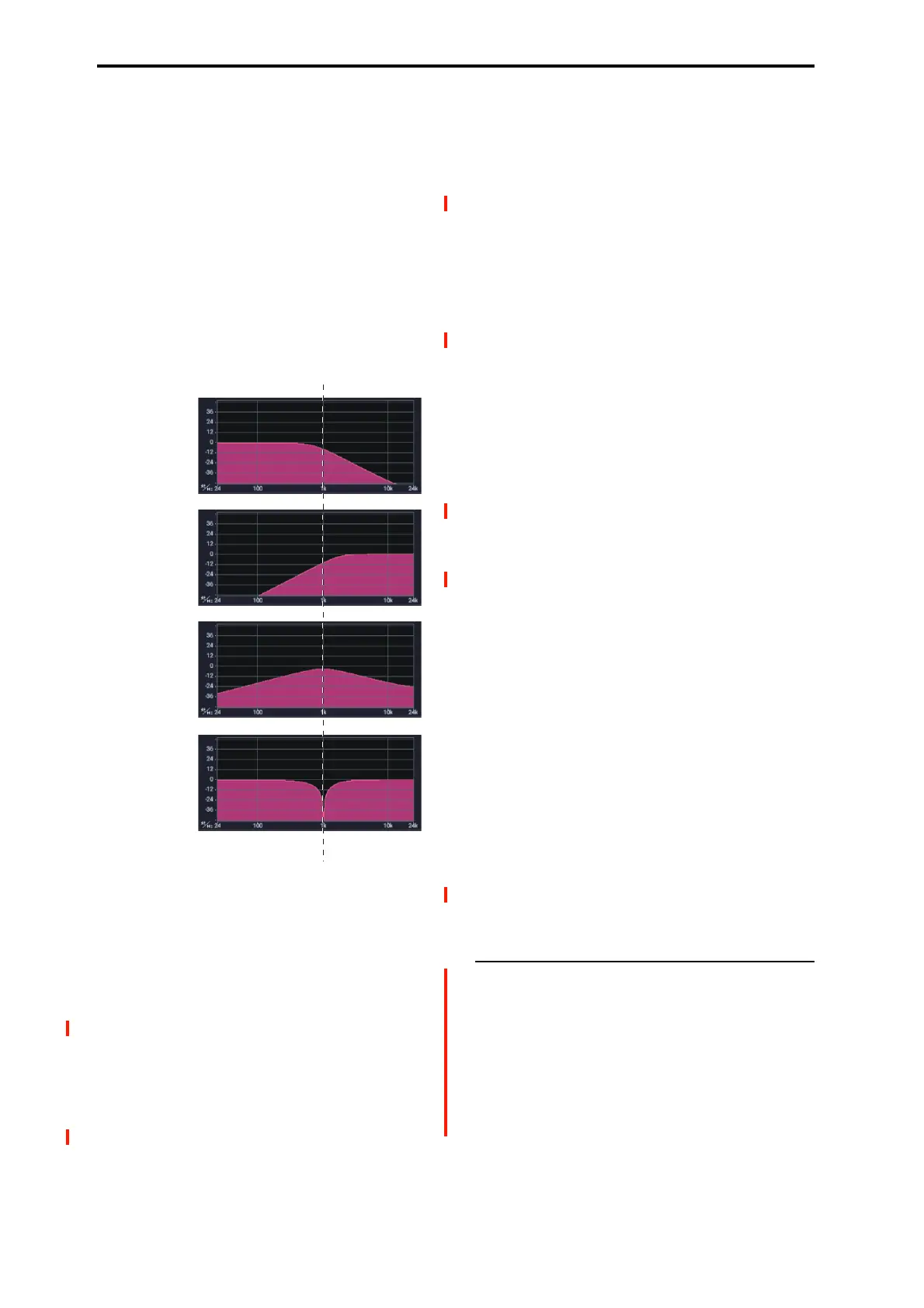EXi: STR-1 Plucked String
220
Band Pass. This cuts out all parts of the sound, both highs
and lows, except for the region around the cutoff frequency.
Since this filter cuts out both high and low frequencies, its
effect can change dramatically depending on the cutoff
setting and the oscillator’s multisample.
With low resonance settings, you can use the Band Pass
filter to create telephone or vintage phonograph sounds.
With higher resonance settings, it can create buzzy or nasal
timbres.
Band Reject. This filter type–also called a notch filter–cuts
only the parts of the sound directly around the cutoff
frequency. Try modulating the cutoff with an LFO to create
phaser-like effects.
Filter Types and Cutoff Frequency
Bypass [Off, On]
This lets you bypass the filter completely.
If Bypass is Off, the filter functions normally.
When Bypass is On, the filter has no effect on the excitation
signal.
Trim [00…99]
This adjusts the volume level at the input to the filter. If you
notice that the sound is distorting, especially with high
Resonance settings, you can turn the level down here.
Note that the filter will not clip internally.
Frequency [00…99]
This controls the cutoff frequency of Filter A, in increments
of 1/10 of an octave. The specific effect of the cutoff
frequency will change depending on the selected Filter
Type, as described above.
AMS 1 [List of AMS Sources]
This selects the first modulation source for controlling the
Frequency. For a list of AMS sources, see “Alternate
Modulation Source (AMS) List” on page 901.
Intensity [-99…+99]
This controls the depth and direction of the AMS 1
Frequency modulation.
Intensity Mod AMS [List of AMS Sources]
You can modulate AMS 1’s Intensity from another AMS
source. This selects that source.
Intensity [-99…+99]
This controls the depth and direction of the Intensity Mod
AMS. The result is summed with the main AMS 1 Intensity
to produce the final Frequency modulation amount.
AMS 2 [List of AMS Sources]
This selects a second modulation source for controlling the
Frequency. For a list of AMS sources, see “Alternate
Modulation Source (AMS) List” on page 901.
Intensity [-99…+99]
This controls the depth and direction of the AMS 2
Frequency modulation.
Resonance [00…99]
Resonance emphasizes the frequencies around the cutoff
frequency.
When this is set to 0, there is no emphasis, and frequencies
beyond the cutoff will simply diminish smoothly.
At medium settings, the resonance will alter the timbre of the
filter, making it sound more nasal, or more extreme.
At very high settings, the resonance can be heard as a
separate, whistling pitch.
To make the resonance track the keyboard pitch, see “Key
Follow,” on page 240.
AMS [AMS Sources]
This selects a modulation source to control the Resonance
amount. For a list of AMS sources, see “Alternate
Modulation Source (AMS) List” on page 901.
Intensity [-99…+99]
This controls the depth and direction of the Resonance
modulation.
v
4–4: Page Menu Commands
• Compare →p.112
• Write Program →p.112
• Exclusive Solo →p.113
• PAGE →p.126
•MODE →p.126
Low Pass
High Pass
Band Pass
Band Reject
Cuto Frequency

